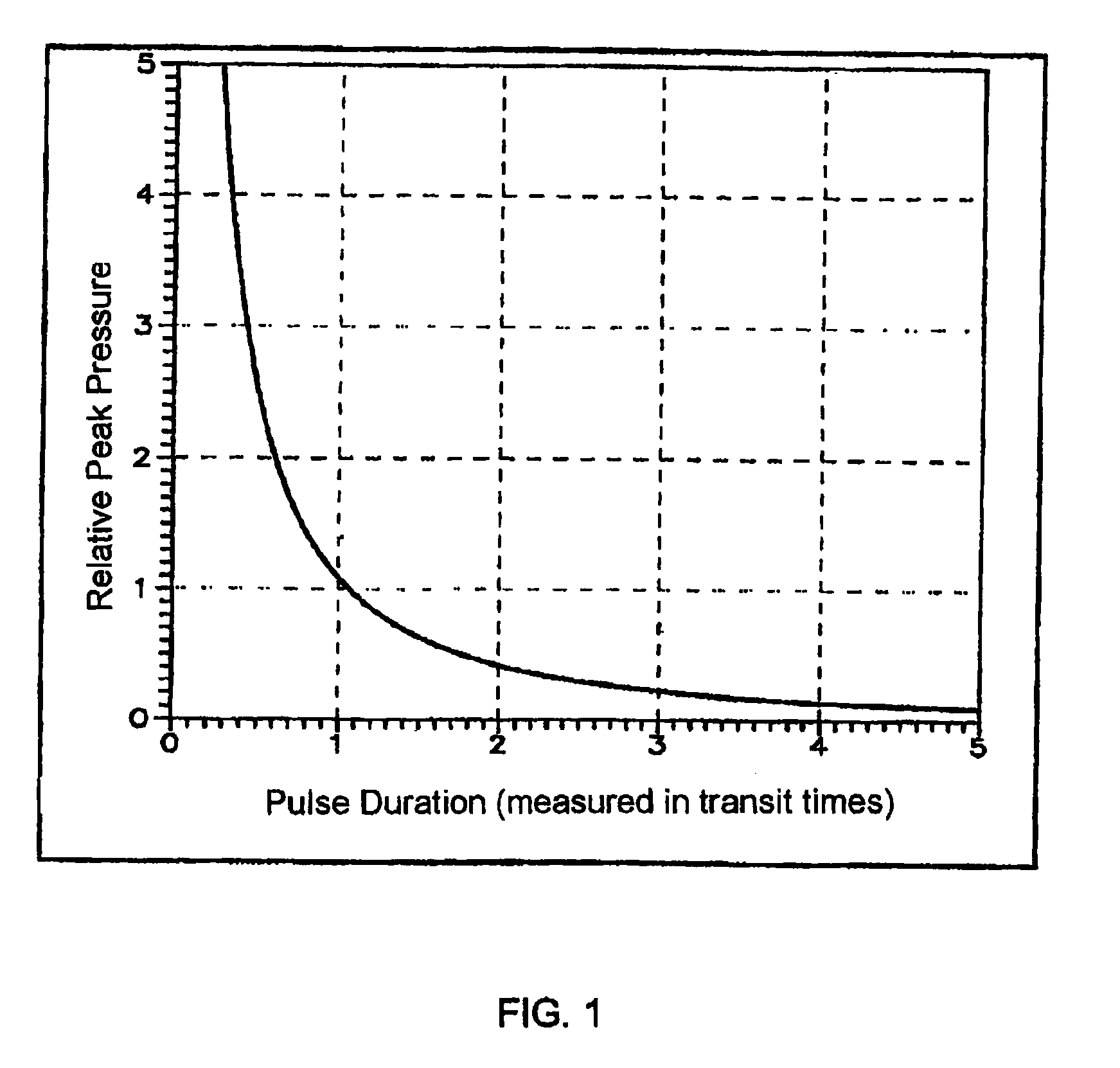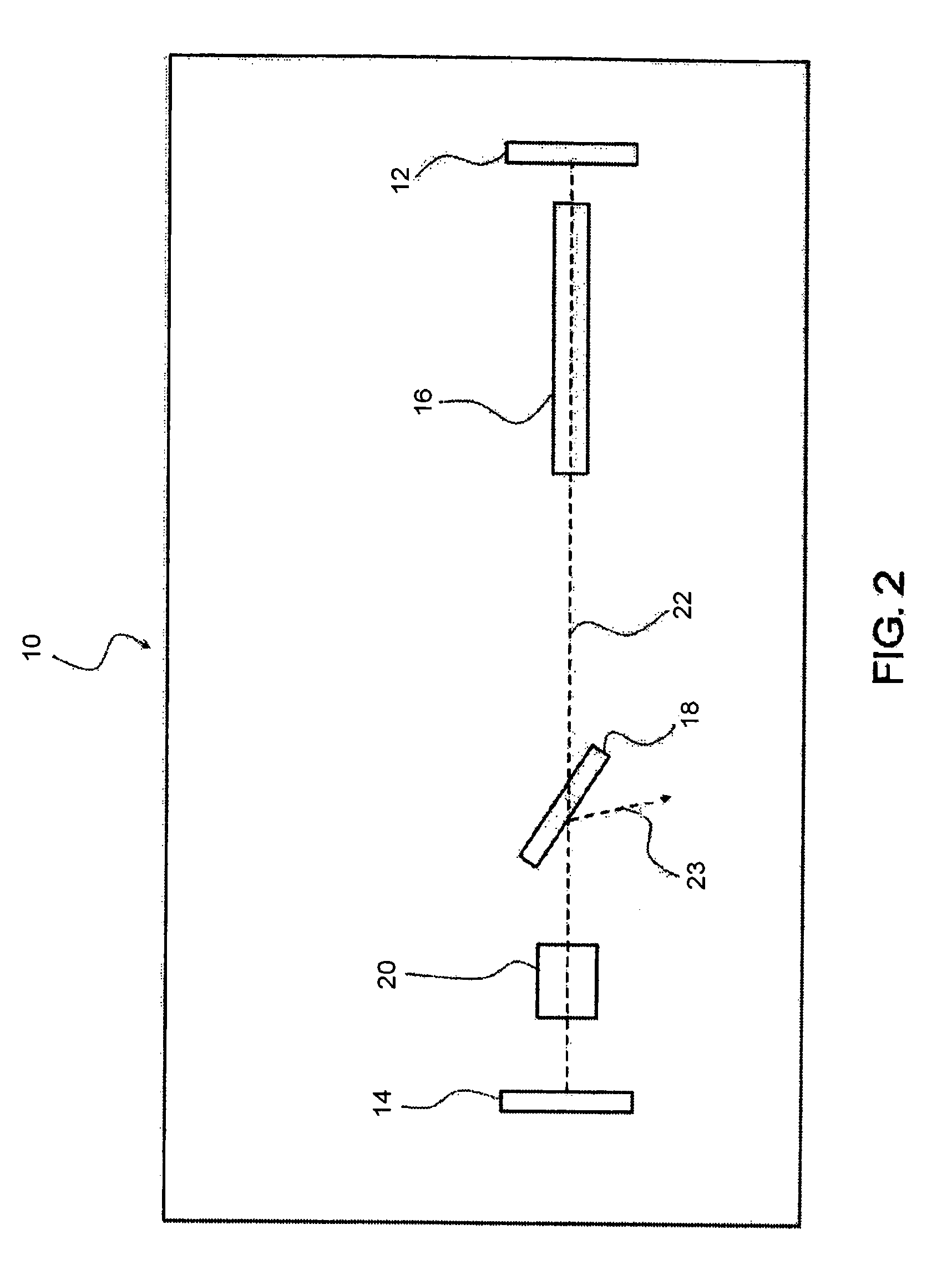[0013]In addition to requiring only a single resonator and lasing (or
gain) medium, apparatuses may be further simplified in that, in a first operating mode, a modelocked pulse is established in the resonator, without the use of an additional modelocking device such as an acousto-optic modulator. Moreover, the need to adjust resonator length, associated with the use of some acousto-optical devices, is eliminated. The overall component and operating requirements of apparatuses according to embodiments of the present invention are therefore considerably simplified. For example, in some cases only four optical components may be required, as is common in many Q-Switched laser systems.
[0016]In a subsequent, second mode of operation, the modelocked pulse is amplified. In the case where the electro-optical device is positioned between the
polarizer and one of the mirrors (arbitrarily denoted the “second” mirror) a first (constant) bias voltage may be applied to the electro-optical device such that a pulse reflected at this second mirror traverses the
polarizer substantially without loss of intensity or amplitude. To extract the energy from the amplified pulse, a second (constant) bias voltage may thereafter be applied to the electro-optical device such that the
polarizer substantially expels a pulse reflected at the second mirror from the resonator. This releases the
pulsed laser energy having the desired characteristics described herein.
[0021]An additional aspect of the present invention involves the use of voltage waveform generating
electronics for applying the necessary voltage during operation to the electro-optical device, in order to invoke the separate and normally sequential operating
modes of the apparatus, as described above. In certain waveform generating
electronics of the present invention, a circuit is used in connection with a first electro-optical device to establish the modelocking mode and the amplification mode, and a separate circuit is used in connection with a second electro-optical device to establish the extraction mode. In this manner separate
electronic modules are connected to at least two different electro-optical elements. According to one embodiment, a three terminal Pockels
cell with two Pockels cell elements or crystals connected internally in series can be used as the electro-optical device with one circuit connected to a first Pockels cell element or
crystal of the three terminal Pockels cell to establish modelocking and amplification and a second circuit connected to a second Pockels cell element or
crystal of the three terminal Pockels cell to establish extraction. In this manner, the separate drive circuits provide for reduced impedance and
improved performance in generating the
pulsed laser light output. In an alternate embodiment, two Pockels cells can be used as the electro-optical device or devices with a first circuit connected to the first Pockels cell to establish modelocking and amplification and a second circuit connected to the second Pockels cell to establish extraction. Again, in this manner, the separate drive circuits provide for reduced impedance and
improved performance in generating the
pulsed laser light output. In a still alternate embodiment, a first Pockels cell having a single Pockels cell element or
crystal and three terminals can be used as the electro-optical device or devices with a first circuit applying a voltage to one half of the single Pockels cell crystal to establish modelocking and amplification and a second circuit applying a voltage to the second half of the single Pockels cell crystal to establish extraction. Again, in this manner, the separate drive circuits provide for reduced impedance and
improved performance in generating the pulsed
laser light output.
[0023]The voltage waveform
electronics may be used for initially applying the baseline voltage, Vo, to the electro-optical device, prior to applying the time-dependent differential voltage, δV(t), which establishes a first, modelocked operating mode, as discussed above. Subsequently, the voltage waveform electronics can apply a first (constant) bias voltage (e.g.,
zero voltage or complete
discharge of the electro-optical device), such that a reflected pulse at the second mirror traverses the polarizer substantially without loss of intensity. Under these conditions the lasing or
gain medium amplifies the laser energy within the resonator, in a second, amplification operating mode, prior to its extraction or release from the apparatus as laser energy having the desirable
pulse characteristics, including the short pulse duration and high
pulse energy discussed above. This generation of such laser energy, for applications discussed herein, is ultimately effected by applying a second bias voltage (e.g., the quarter wave voltage) to the electro-optical device, such that a pulse reflected at the second mirror is substantially expelled from the resonator at the polarizer.
 Login to View More
Login to View More  Login to View More
Login to View More 


